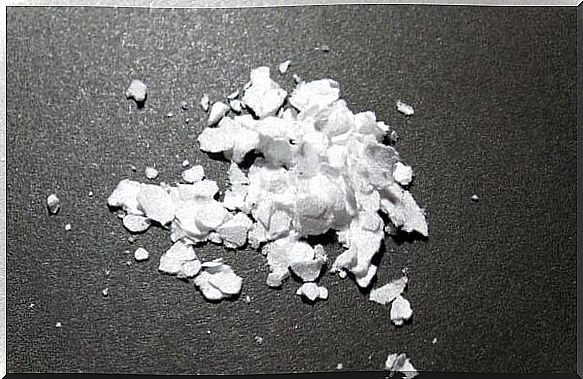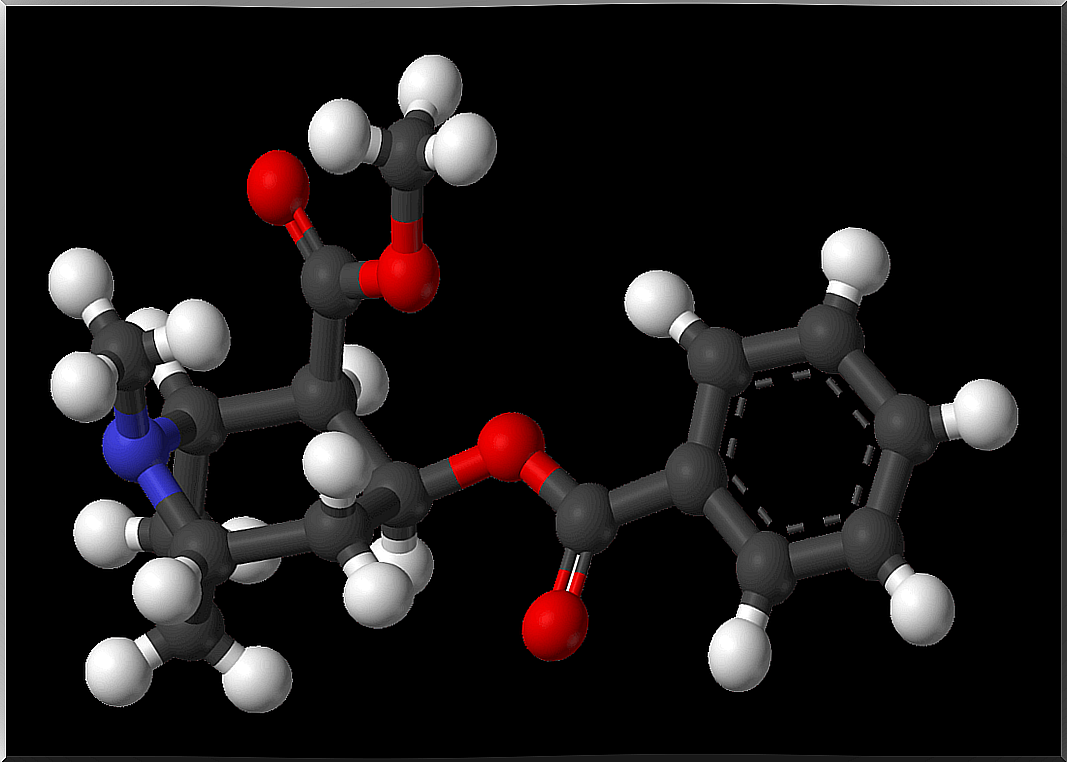Cocaine: Types And Effects

Cocaine is a powerful, extremely addictive stimulant, almost always used as a recreational drug. It comes from the coca leaf and began to become very popular during the eighties. In its natural form as a shrub, it has been consumed for thousands of years by the native peoples of America.
Its pure chemical form is cocaine hydrochloride, a substance made in the laboratory for more than 100 years. At the beginning of the 20th century, this compound was the active principle of several elixirs and tonics that were used for medicinal purposes. Currently it is still used as an anesthetic for throat, ear and eye surgeries.
Cocaine was also used as a component of various soft drinks. The best known of them is “Coca-Cola”. The original formula of the brand’s flagship drink contained up to 8 milligrams of cocaine per liter. However, this drug began to become unpopular due to its severe effects and Coca-Cola withdrew it from its prescription in 1903. In 1914 it became an illegal drug.
It is currently difficult to find cocaine in its chemically pure form. This is mixed with some starches, talc, sugar or other elements. In street sales, the substance receives different names such as “parakeet”, “snow”, “white lady”, “talcum” or simply “coca”. In English they are given names like “blow”, “flake”, “coke” or “snow”.
Cocaine hydrochloride
As we have already indicated, its pure chemical form is cocaine hydrochloride. Although the purity levels of this vary depending on the handling that is made of it. The highest quality cocaine reaches up to 98% purity and is known as “Yen” on the black market. It is the most expensive and has a whiter and brighter appearance than the others.

Hydrochloride comes as a powder. It is estimated that the cocaine powder that is sold on the streets is normally between 5% and 40% pure. Sometimes it is mixed with very dangerous substances such as amphetamines or certain anesthetics. Powdered cocaine is typically snorted or “snorted.” However, it is also common to inject.
There are different varieties of “white cocaines” of medium or low purity. The most popular is one known as “chalk.” It is so called because it has a greyish white color and little brightness. This strain is highly euphoric. There is also another category that is called “yellowish cocaines.” The most characteristic of these is their strong smell of gasoline or kerosene. They are the most powerful of all.
Other types of cocaine
Cocaine is also in “base” form. It is what is popularly known as “crack”. Its use began to spread when the authorities activated strong restrictions on the chemicals necessary to obtain cocaine hydrochloride. This caused the price of the same to rise to levels unattainable for many consumers. Situation that caused the commercialization of the base, which is up to 15 times cheaper.
The crack is a mixture of cocaine hydrochloride and other chemicals as ammonia, ether and sodium bicarbonate. It is normally smoked in a pipe and its effects are much more severe than those of cocaine hydrochloride. It is also potentially more addictive and increases the risk of death. They call it “crack” because of the sound it makes when it is crushed.
Another form of this drug is the so-called “basuco” or coca paste, which is also called “cocaine sulfate”. This is because up to 50% of this substance is a sulfate. During its production, highly toxic components are used, such as methanol or sulfuric acid. It is usually combined with marijuana or tobacco and smoked.
Both crack and basuco produce a “flash” type effect. This means that it is fast and very powerful. For this reason, addicts find it necessary to consume several successive doses, to prolong the effect. Both have a high risk of overdose.
The short-term effects of cocaine
The effects of cocaine appear almost immediately after consuming it. Sometimes they last a few minutes and other times they last an hour. The substance causes feelings of euphoria and great vitality. The user feels mentally alert and heightens his sensory perceptions, especially in sight, hearing and touch.
It is common for cocaine to decrease the need to eat and sleep. Some users report that the drug helps them perform their tasks much faster. Others, on the other hand, perceive that it slows them down.

The duration and intensity of the effect depend on the type of cocaine used and the method used to ingest it. The faster the absorption, the higher the intensity of the effect, but also the shorter. Sometimes feelings of restlessness, anguish and irritability appear. Spasms, paranoia, and dizziness are also common.
From an organic point of view, cocaine alters the heart rate and can cause headaches, abdominal pain and vomiting. If there is an overdose, the user may have seizures, stroke, or fall into a coma. Sudden death is rare, but cardiac arrest leading to death do occur.
Long-term effects
The main long-term effect of cocaine is severe addiction. Because the addictive potential is extremely high, it is not possible for a person to predict the extent to which they will need the drug after the first time they use it. There is also a high risk of relapse when it is stopped. This happens even several years after you quit the drug.
The brain adapts to cocaine use. This means that the feeling of gratification is less and less. Therefore, the addict must take higher doses or more frequently to obtain the same pleasant sensation as the first few times. Over time, the annoying effects of the drug begin to increase, such as feelings of anguish, paranoia, or outbursts of anger.
In the most serious cases, the sense of reality is lost for long periods of time. Hallucinations appear, mainly auditory, and you can fall into a state of paranoid psychosis.
Magnetic resonance imaging shows that there is a decrease in dopamine receptors in the brain of a cocaine addict. The consequence of this is that the person becomes unable to experience gratifying sensations naturally.
The future of an addict
It is very difficult to predict what will be the fate of a person addicted to cocaine, since this depends on many factors and even chance. As long as consumption is maintained, the risk of death progressively increases. Also damage to personality and relationships with others.
Currently, they are testing various drug treatments, but none of them has passed all tests.

Self-help groups are always an excellent alternative. The usual thing is that they are accompanied by individual therapy. This, plus an adequate diet, a constant exercise plan and a support network, seems to give good results in most cases.
Now, getting out of addiction is not easy. Therefore, it is always best to prevent. Cocaine is not a drug to try out of curiosity or to live a new experience. A single use has the potential to trigger a series of situations that, in the long run, could end up becoming a tragedy.
Pharmacotherapy
Drug treatment for cocaine addicts is still in full swing. The definitive solution has not yet been found, but there are some enzymes that can be quite useful. Team Salazar-Juarez (2016) sheds light on the finding promising results. Enzymes such as BChE, COCH, and bacterial CoCe have been shown to significantly lower dose levels. This decrease would occur both at blood levels and in the brain.
These enzymes have been shown to be very effective in cases of overdose, making them a very effective tool for emergency teams. In this way the lethal effects could be reduced. Studies in animals have also shown that these enzymes have the potential to rapidly deactivate cocaine and develop an effective treatment for preventing relapse and maintaining abstinence.









